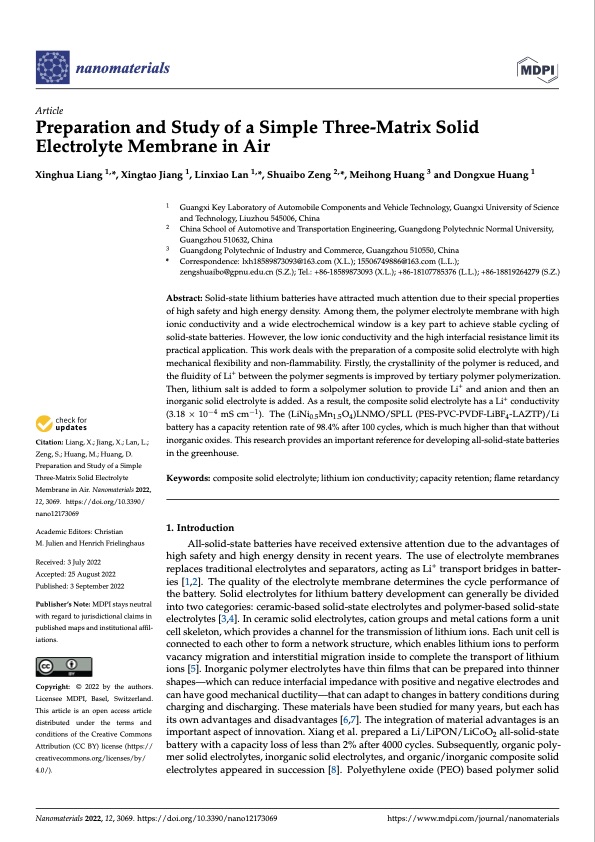
PDF Publication Title:
Text from PDF Page: 001
nanomaterials Article Preparation and Study of a Simple Three-Matrix Solid Electrolyte Membrane in Air Xinghua Liang 1,*, Xingtao Jiang 1, Linxiao Lan 1,*, Shuaibo Zeng 2,*, Meihong Huang 3 and Dongxue Huang 1 1 2 3 Abstract: Solid-state lithium batteries have attracted much attention due to their special properties of high safety and high energy density. Among them, the polymer electrolyte membrane with high ionic conductivity and a wide electrochemical window is a key part to achieve stable cycling of solid-state batteries. However, the low ionic conductivity and the high interfacial resistance limit its practical application. This work deals with the preparation of a composite solid electrolyte with high mechanical flexibility and non-flammability. Firstly, the crystallinity of the polymer is reduced, and the fluidity of Li+ between the polymer segments is improved by tertiary polymer polymerization. Then, lithium salt is added to form a solpolymer solution to provide Li+ and anion and then an inorganic solid electrolyte is added. As a result, the composite solid electrolyte has a Li+ conductivity (3.18 × 10−4 mS cm−1). The (LiNi0.5Mn1.5O4)LNMO/SPLL (PES-PVC-PVDF-LiBF4-LAZTP)/Li battery has a capacity retention rate of 98.4% after 100 cycles, which is much higher than that without inorganic oxides. This research provides an important reference for developing all-solid-state batteries in the greenhouse. Keywords: composite solid electrolyte; lithium ion conductivity; capacity retention; flame retardancy 1. Introduction All-solid-state batteries have received extensive attention due to the advantages of high safety and high energy density in recent years. The use of electrolyte membranes replaces traditional electrolytes and separators, acting as Li+ transport bridges in batter- ies [1,2]. The quality of the electrolyte membrane determines the cycle performance of the battery. Solid electrolytes for lithium battery development can generally be divided into two categories: ceramic-based solid-state electrolytes and polymer-based solid-state electrolytes [3,4]. In ceramic solid electrolytes, cation groups and metal cations form a unit cell skeleton, which provides a channel for the transmission of lithium ions. Each unit cell is connected to each other to form a network structure, which enables lithium ions to perform vacancy migration and interstitial migration inside to complete the transport of lithium ions [5]. Inorganic polymer electrolytes have thin films that can be prepared into thinner shapes—which can reduce interfacial impedance with positive and negative electrodes and can have good mechanical ductility—that can adapt to changes in battery conditions during charging and discharging. These materials have been studied for many years, but each has its own advantages and disadvantages [6,7]. The integration of material advantages is an important aspect of innovation. Xiang et al. prepared a Li/LiPON/LiCoO2 all-solid-state battery with a capacity loss of less than 2% after 4000 cycles. Subsequently, organic poly- mer solid electrolytes, inorganic solid electrolytes, and organic/inorganic composite solid electrolytes appeared in succession [8]. Polyethylene oxide (PEO) based polymer solid Guangxi Key Laboratory of Automobile Components and Vehicle Technology, Guangxi University of Science and Technology, Liuzhou 545006, China China School of Automotive and Transportation Engineering, Guangdong Polytechnic Normal University, Guangzhou 510632, China Guangdong Polytechnic of Industry and Commerce, Guangzhou 510550, China * Correspondence: lxh18589873093@163.com (X.L.); 15506749886@163.com (L.L.); zengshuaibo@gpnu.edu.cn (S.Z.); Tel.: +86-18589873093 (X.L.); +86-18107785376 (L.L.); +86-18819264279 (S.Z.) Citation: Liang, X.; Jiang, X.; Lan, L.; Zeng, S.; Huang, M.; Huang, D. Preparation and Study of a Simple Three-Matrix Solid Electrolyte Membrane in Air. Nanomaterials 2022, 12,3069. https://doi.org/10.3390/ nano12173069 Academic Editors: Christian M. Julien and Henrich Frielinghaus Received: 3 July 2022 Accepted: 25 August 2022 Published: 3 September 2022 Publisher’s Note: MDPI stays neutral with regard to jurisdictional claims in published maps and institutional affil- iations. Copyright: © 2022 by the authors. Licensee MDPI, Basel, Switzerland. This article is an open access article distributed under the terms and conditions of the Creative Commons Attribution (CC BY) license (https:// creativecommons.org/licenses/by/ 4.0/). Nanomaterials 2022, 12, 3069. https://doi.org/10.3390/nano12173069 https://www.mdpi.com/journal/nanomaterialsPDF Image | Simple Three-Matrix Solid Electrolyte Membrane in Air

PDF Search Title:
Simple Three-Matrix Solid Electrolyte Membrane in AirOriginal File Name Searched:
nanomaterials-12-03069.pdfDIY PDF Search: Google It | Yahoo | Bing
Product and Development Focus for Salgenx
Redox Flow Battery Technology: With the advent of the new USA tax credits for producing and selling batteries ($35/kW) we are focussing on a simple flow battery using shipping containers as the modular electrolyte storage units with tax credits up to $140,000 per system. Our main focus is on the salt battery. This battery can be used for both thermal and electrical storage applications. We call it the Cogeneration Battery or Cogen Battery. One project is converting salt (brine) based water conditioners to simultaneously produce power. In addition, there are many opportunities to extract Lithium from brine (salt lakes, groundwater, and producer water).Salt water or brine are huge sources for lithium. Most of the worlds lithium is acquired from a brine source. It's even in seawater in a low concentration. Brine is also a byproduct of huge powerplants, which can now use that as an electrolyte and a huge flow battery (which allows storage at the source).We welcome any business and equipment inquiries, as well as licensing our flow battery manufacturing.| CONTACT TEL: 608-238-6001 Email: greg@salgenx.com | RSS | AMP |